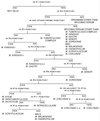Performance assessment of new multiplex probe assay for identification of mycobacteria
- PMID: 11230430
- PMCID: PMC87876
- DOI: 10.1128/JCM.39.3.1079-1084.2001
Performance assessment of new multiplex probe assay for identification of mycobacteria
Abstract
A new DNA probe assay (INNO LiPA Mycobacteria; Innogenetics, Ghent, Belgium) for the simultaneous identification, by means of reverse hybridization and line-probe technology, of Mycobacterium tuberculosis complex, Mycobacterium kansasii, Mycobacterium xenopi, Mycobacterium gordonae, the species of the Mycobacterium avium complex (MAC), Mycobacterium scrofulaceum, and Mycobacterium chelonae was evaluated on a panel of 238 strains including, besides representatives of all the taxa identifiable by the system, a number of other mycobacteria, some of which are known to be problematic with the only other commercial DNA probe system (AccuProbe; Gen-Probe, San Diego, Calif.), and two nocardiae. The new kit, which includes a control probe reacting with the whole genus Mycobacterium, correctly identified 99.6% of the strains tested; the one discrepancy, which remained unresolved, concerned an isolate identified as MAC intermediate by INNO LiPA Mycobacteria and as Mycobacterium intracellulare by AccuProbe. In five cases, because of an imperfect checking of hybridization temperature, a very slight, nonspecific, line was visible which was no longer evident when the test was repeated. Two strains whose DNA failed amplification at the first attempt were regularly identified when the test was repeated. Interestingly, the novel kit dodged all the pitfalls presented by the strains giving anomalous reactions with AccuProbe. A unique feature of INNO LiPA Mycobacteria is its ability to recognize different subgroups within the species M. kansasii and M. chelonae, while the declared overlapping reactivity of probe 4 with some M. kansasii and Mycobacterium gastri organisms and of probe 9 with MAC, Mycobacterium haemophilum, and Mycobacterium malmoense, may furnish a useful aid for their identification. The turnaround time of the method is approximately 6 h, including a preliminary PCR amplification.
Figures


References
-
- Abed Y, Bollet C, De Micco P. Identification and strain differentiation of Mycobacterium species on the basis of DNA 16S–23S spacer region polymorphism. Res Microbiol. 1995;146:405–413. - PubMed
-
- Alcaide F, Richter I, Bernasconi C, Springer B, Hagenau C, Schulze-Röbbecke R, Tortoli E, Martín R, Böttger E, Telenti A. Heterogeneity and clonality among isolates of Mycobacterium kansasii: implications for epidemiological and pathogenicity studies. J Clin Microbiol. 1997;35:1959–1964. - PMC - PubMed
Publication types
MeSH terms
Substances
LinkOut - more resources
Full Text Sources
Other Literature Sources

